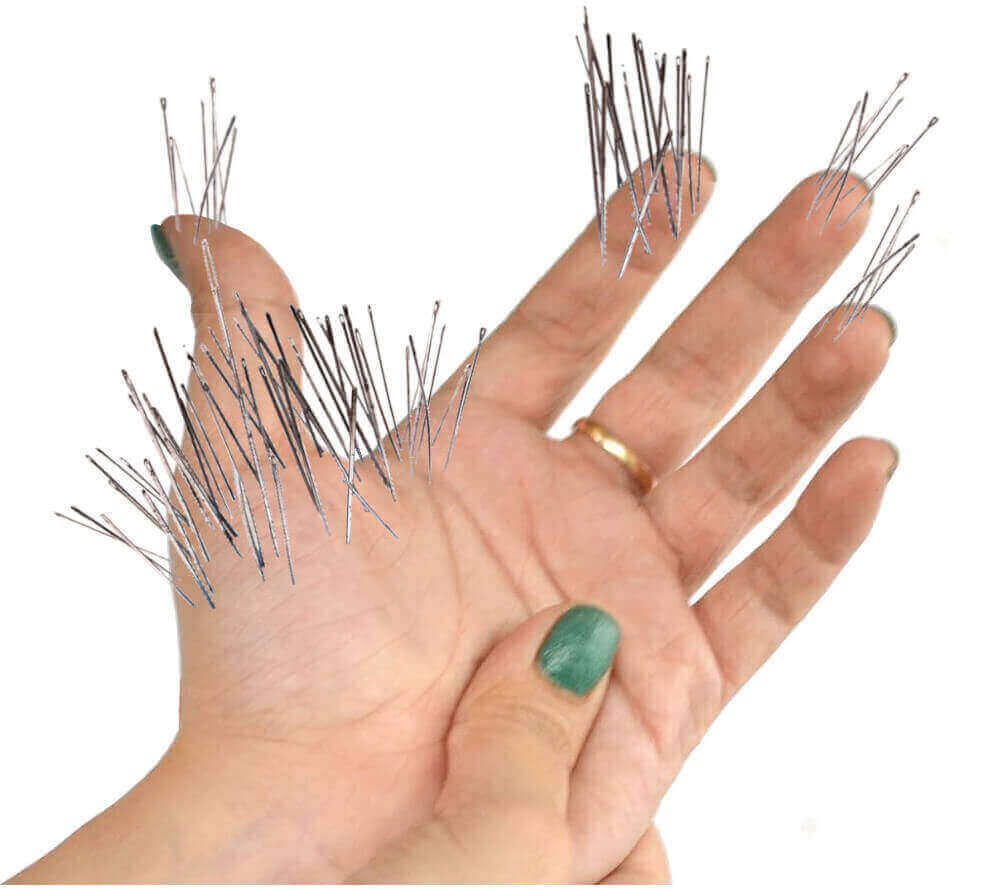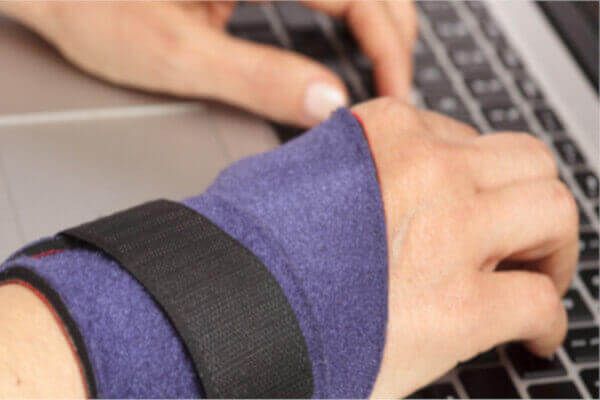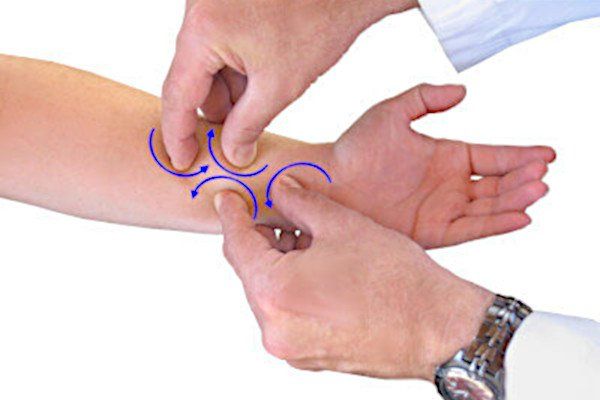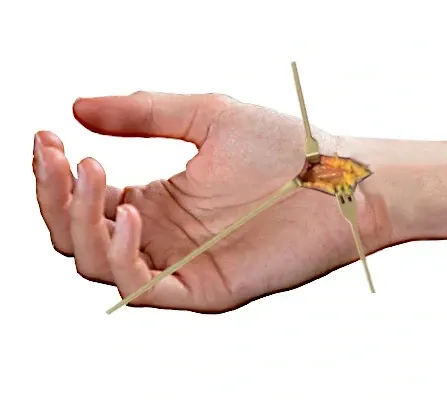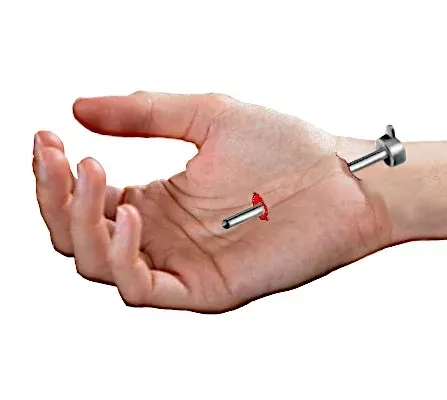Having Pain with Carpal Tunnel
Carpal tunnel syndrome can cause extreme numbness in your fingers and hand. But there's another side to it.
Pain
with carpal tunnel can be excruciating and unrelenting. And if you're unlucky, you'll experience numbness AND pain at the same time - perhaps with other symptoms like
hand weakness and clumsiness.
The sensation of pain with carpal tunnel varies from person to person. It can be continuous or intermittent. And the pain can have qualities ranging from a
dull ache
to a
sharp, shooting electric shock.
Numbness with carpal tunnel is also variable. It can range from
mild
to
severe loss of sensation in parts of the hand or fingers, especially the fingertips. Sometimes it can have a tingly or prickly quality. It's also generally continuous, without interruption, especially when your hand is resting.
This article describes the pain with carpal tunnel syndrome. It also describes other key signs and symptoms. Most importantly, it outlines how you can eliminate the disorder for good.
Signs carpal tunnel is starting
When carpal tunnel first begins, you barely even notice its
signs. And every person who has the disorder describes it a bit differently.
Usually the carpal tunnel pain or numbness bothers you only while trying to sleep. Either pain or numbness can be intermittent or last the entire night.
In its earliest stage (the "mild" stage) carpal tunnel syndrome usually shows up as pain OR numbness in the hand and fingers. These are the 2 primary symptoms of carpal tunnel syndrome.
Usually the thumb, first, and middle fingers are more numbing or painful. And at first, symptoms almost always appear at night. Patients often complain they can't get a good night's sleep. They have to
wake up and either
shake out the numbness or
rub out the pain.
What carpal tunnel
pain feels like
Whether in it's early stage or more advanced stages, carpal tunnel pain can have any of the following qualities:
- Deep or dull aching
- Throbbing
- Sharp, stinging or stabbing
- Shooting electric shocks
- Burning or itching
Rubbing out the pain usually doesn't help much. But some people get relief by hanging their hand off the bedside. Taking pain medicines like
nonsteroidal anti-inflammatory drugs (or NSAIDs) including Aleve, Tylenol, Advil, Motrin can also help relieve pain. But the relief is only temporary. Likewise, some people feel temporary relief by soaking their hands in an ice bath.
As the condition worsens, pain will creep into the daytime. The pain may appear when gripping objects, twisting a doorknob, lifting something heavy, or holding a phone to your ear. During these times, it's common for the pain to feel more like a shooting electric shock.
What carpal tunnel
numbness feels like
Carpal tunnel numbness is described differently from person to person. The numbness is actually a condition called
paresthesia. This means the nerve carrying a normal signal (like touch sensation) gets jumbled or confused. The result is you feel not a touch, but another sensation like a numbness.
The most common descriptions of numbness you feel with carpal tunnel syndrome are:
- Total loss of feeling
- Coldness
- Buzzing/vibrating feeling when touched
- Like wearing a glove
- Tingling or prickling
- Light pins and needles
- Sharp pinpricks
Other key signs of carpal tunnel syndrome
As the condition worsens, carpal tunnel pain will creep into the daytime. The pain may appear when gripping objects, twisting a doorknob, lifting something heavy, or holding a phone. During these times, it's common for the pain to feel like a sharp stabbing or shooting electric shock.
As the disease's progresses, most people feel
some degree of numbness in their fingers or hand. The numbness can range from a mild discomfort to a horrible crushing. And it can occur anywhere from the fingertips to the wrist.
Some people also feel a separate tingling or
pins-and-needles, particularly in the fingers. The tingly sensation can range from a widespread prickly feeling to painful pinpricks.
Other signs your carpal tunnel is progressing are:
- It's difficult to lift or grip something securely.
- Your hands or fingers feel puffy.
- Holding objects for long periods makes your hand tired, crampy, and sore.
- You're clumsy tying a shoelace, holding a cup, turning a knob, holding a pen, or buttoning a shirt.
Signs your carpal tunnel is "severe"
As carpal tunnel syndrome advances, it goes from a mere annoyance to making your life a total misery. This is called the
severe stage.
In the severe stage, any numbness or pain with carpal tunnel is usually maximally intense
-- even excruciating. To relieve the pain or numbness, patients often say, "I feel like cutting my hand off."
When there's numbness in the severe stage of carpal tunnel syndrome it can feel brutal. Patients often describe it as their hand or fingers
"being crushed in a vice."
The numbness is relentless, with almost no relief from it.
Similarly, when the condition advances to the severe stage, you will usually experience extreme finger or hand pain. With carpal tunnel pain, patients describe it as cruel, excruciating, or punishing. It's also unrelenting, even during the daytime.
Also by the severe stage, most patients have lost some ability to feel hot or cold in their fingers. Usually the loss in in the fingertips. Severe stage carpal tunnel patients must take precautions to not burn their hand and fingers, especially in the kitchen. It's not uncommon for them to scald or burn themselves due to the lack of sensation.
By the severe stage, most patients also have
catastrophic functional loss.
That means any of the following can occur:
- Grip strength diminishes, and it's difficult or impossible to squeeze something.
- Manual dexterity is severely compromised, making typing, writing, or performing fine motor tasks nearly impossible.
- Holding anything securely is impossible, and dropping things (even children) is commonplace.
In most cases, the thumb muscle (thenar muscle or thenar eminence - at the bas of the thumb) degenerates. You can see this by it's flat and wrinkly appearance. This is a primary reason your thumb weakens and grip strength diminishes.
End stage carpal tunnel syndrome
When carpal tunnel syndrome reaches the final or "end stage" (also called
atrophy stage) there is nothing which can be done to relieve symptoms. This is because the median nerve has essentially died. It no longer
conducts signals near the hand. And the nerve cannot be revived at this point. Therefore,
even surgery is of little help. In fact, most hand surgeons are reluctant to perform carpal tunnel release surgery at this point due to the
low probability of success.
Ironically, pain with carpal tunnel subsides during the end stage. That's because the median nerve, being essentially dead, no longer transmits signals of sensations like pain or touch. However, numbness, tingling, weakness, and all of the other symptoms of carpal tunnel syndrome remain forever.
Warning!
Sure, having extreme numbness or pain with carpal tunnel syndrome is bad enough. And having a weakened hand and dexterity problems makes it an even bigger problem to live with.
But there are four
WARNINGS
about this disorder you need to be aware of.
Waiting too long to treat
Carpal tunnel syndrome is
highly treatable without surgery in the mild stage. Usually only night splinting and rest are needed. But the longer you wait, the more challenging an effective treatment becomes.
So why don't patients treat right away? The major reason is that carpal tunnel syndrome goes
practically unnoticed during the mild stage. Most people think they just overworked their hand. They typically attribute their pain or numbness to,
"I typed too much"
or
"I did a lot of yard work."
Therefore, many people tend to ignore the
first signs of carpal tunnel syndrome. But when pain or numbness happen while doing certain tasks over and over, like driving their car, they take notice. They realize that (e.g., whenever they hold a steering wheel) they feel numbness, pain or tingling in their fingers or palm. But by this point, they've usually reached the
moderate stage of the disorder.
From the day patients realize,
"I have a problem" to where symptoms progress to the
severe stage, generally takes about
6-12 months. If you don't begin serious therapy before then, reversing symptoms is
far more challenging.
Carpal tunnel is usually bilateral
Carpal tunnel syndrome is considered a
"bilateral" condition. That means over 88% of the time, patients feel symptoms in both hands within 6 months of symptoms appearing in the first hand.
If you don't treat one hand with symptoms, pretty soon you'll have to deal with both hands simultaneously. Such makes activities of daily living difficult. And it's also more challenging to treat as the condition advances.
Don't wear the wrong brace!
When symptoms begin to appear at night, many patients start wearing a night brace to sleep. If you've done this, you no doubt noticed the brace makes symptoms even worse.
Why? It's the wrong type of brace!
You're almost surely wearing a
drugstore brace (from CVS, Walgreens, Walmart, etc.). Those braces are harmful if you have carpal tunnel syndrome. Even though the brace might have a label claiming it "relieves carpal tunnel", it won't.
The reason is because such braces contain a
palmar spine (inspect your brace and see).
The spine pushes into your wrist joint, further damaging your (already damaged ) median nerve.
Only a
certified carpal tunnel brace is manufactured with the spine on the
side
or
back of the hand. This will not cause median nerve damage.
Never wear a brace during the daytime
When carpal tunnel symptoms begin to appear during the daytime, many patients start wearing a wrist brace while working. Wearing a brace while your hand is active will delay healing. And it can even worsen symptoms. Here's why.
The tissues in your wrist are already damaged from the carpal tunnel syndrome. Wearing a brace while your hand is doing its regular daily activity
adds to the workload. In other words, your hand has to do its normal job, while also overcoming the movement restriction of the brace. This
doubles the stress your wrist must endure.
Therefore, never wear a wrist brace during the daytime when you have carpal tunnel syndrome.
How to treat carpal tunnel
Carpal tunnel syndrome is a progressive disorder. If you feel symptoms and do nothing, your chances are
about 66% it will worsen over the coming months.
And it just doesn't stop at numbness and pain. Carpal tunnel can leave your hand and fingers weak, clumsy, and nearly useless. In the end, your median nerve will die. This means catastrophic loss of hand and finger function.
But the sooner you treat, the better the chances of restoring your hand to normal again.
Studies show that when patients treat their symptoms early, they see almost complete resolution of symptoms.
There are 2 major ways to treat carpal tunnel syndrome:
Non-surgical
(conservative) remedies
and Surgery.
Surgery doesn't always result in good outcomes. In fact, about
50% of surgery patients are dissatisfied with their results at 2 years.
In contrast, appropriate
non-surgical treatments can eliminate symptoms and restore hand function in virtually every patient. Patients who treat carpal tunnel early and maintain their treatment regimen will usually see all symptoms eliminated.
Non-surgical remedies
By far, most people successfully treat carpal tunnel syndrome using 4 key non-surgical remedies compared to having surgery. The reason is because these methods are effective carpal tunnel fighters.
The 4 key remedies are:
- Steroid injections
- Myofascial release massage
- Night bracing
- Carpal tunnel stretching exercises
Each is discussed below. Note that if your carpal tunnel symptoms are more severe, you will require two or more of these remedies simultaneously.
Steroid injections
Myofascial release massage
Night bracing
Carpal tunnel stretching exercises
Surgery
Some people choose to have hand surgery to treat their carpal tunnel syndrome. The
American Academy of Orthopedic Surgeons advise doctors to recommend surgery to patients once the patient has tried all non-surgical remedies first.
Certainly, electing surgery is one way to treat carpal tunnel numbness and pain. With carpal tunnel surgery, your doctor will advise one of two types of this hand operation:
- Open carpal tunnel release surgery
- Endoscopic carpal tunnel release surgery
Both procedures have one goal; to cut the
transverse carpal ligament. This is a strong fibrous band of tissue holding your wrist bones together. Cutting the ligament allows your wrist bones to snap apart. This provides more room for your median nerve so it's no longer crushed by swollen flexor tendons.
Each surgical procedure has its advantages and disadvantages or
"pros and cons". These should be discussed thoroughly with your doctor. If you decide on having surgery, be sure the procedure is right for your particular circumstances.
Open carpal tunnel release surgery
Endoscopic carpal tunnel release surgery
Summary
Numbness and pain with carpal tunnel syndrome is the rule, not the exception. In the beginning of the disorder, either sensation can be annoying. But as it progresses, both numbness and pain become excruciating. Other symptoms often also accompany the numbness and pain. These include tingling, hand weakness, loss of dexterity, and loss of temperature sensitivity. It's best to treat carpal tunnel syndrome as early as possible. Doctors recommend non-surgical remedies such as steroid shots, myofascial release massage, night bracing, and stretching exercises. Only if these methods fail should you consider discussing carpal tunnel release surgery with your doctor.



